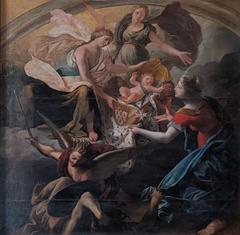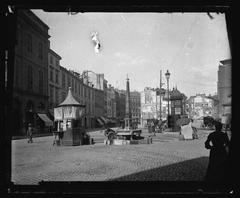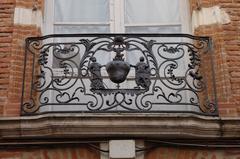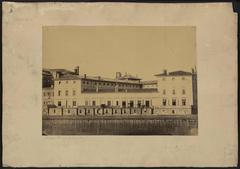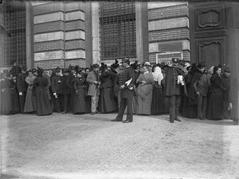
Hôpital de La Grave Toulouse: Visiting Hours, Tickets, and Historical Significance
Date: 04/07/2025
Introduction
Nestled along the left bank of the Garonne River in Toulouse, France, Hôpital de La Grave is an iconic landmark that encapsulates the city’s centuries-old commitment to healthcare, charity, and architectural beauty. With origins tracing back to the 12th century, this former hospital complex has evolved from a medieval leprosarium to a refuge for the marginalized and, today, a vibrant cultural heritage site. Its most recognizable feature, the domed Chapelle Saint-Joseph, is a striking presence on the Toulouse skyline and a symbol of the city’s enduring humanitarian values.
This guide provides a comprehensive overview for visitors, covering Hôpital de La Grave’s history, architectural and cultural significance, visiting hours, ticketing, accessibility, transportation, and nearby attractions. Whether you’re a history enthusiast, architecture aficionado, or cultural explorer, understanding La Grave’s unique legacy will enhance your visit to this Toulouse historical site.
Historical Overview
Origins and Early Development
Hôpital de La Grave was founded in the 12th century amid recurring outbreaks of plague and other epidemics in Toulouse. Its name derives from the Occitan word for “gravel,” referencing the riverbank terrain where the hospital was established. Initially serving as a leprosarium and shelter for society’s most vulnerable, La Grave reflected medieval practices for isolating and caring for the sick and destitute. By the 14th century, it had grown into a general hospice, providing refuge not only to the sick but also to orphans, the poor, and abandoned children (source).
Architectural Evolution
The hospital complex underwent significant expansions from the 17th to 19th centuries. Its most prominent feature, the Dôme de La Grave, crowns the Chapelle Saint-Joseph and was completed in 1845, designed by Jacques-Pascal Virebent. The complex eventually included multiple courtyards, specialized wards, and annexed buildings such as the former convent of the Clarisses, which became a psychiatric ward in 1797. Architectural adaptations—such as robust walls to withstand periodic flooding—mirrored the hospital’s evolving functions and the needs of Toulouse’s growing population (source).
Role in Toulouse’s Social and Medical History
For centuries, La Grave was the principal institution caring for the city’s indigent, sick, mentally ill, and marginalized populations. Its wards housed the elderly, orphans, those suffering from infectious diseases, and even individuals labeled as “undesirable” by society. The hospital’s humanitarian mission was matched by its pioneering role in medical innovation—serving as a site for early smallpox vaccinations and the development of humane psychiatric treatment under figures like Philippe Pinel and Étienne Esquirol (source).
Humanitarian Legacy and Medical Advances
La Grave became synonymous with medical humanism, combining scientific progress with compassionate care. By the 20th century, it had established maternity, psychiatric, and cancer treatment centers, all while continuing its legacy as a place of refuge for the vulnerable. The hospital’s history reflects the broader societal shift from religious charity toward specialized public health and scientific medicine (source).
Visiting Hôpital de La Grave: Practical Information
Location and Access
- Address: 44 Rue Reclusane, 31300 Toulouse, France
- District: Saint-Cyprien, left bank of the Garonne River
- Metro: Line A, Saint-Cyprien – République (5 min walk)
- Buses: Lines 14, 34, 45, 66 (Place Lange stop)
- Cycling: VélôToulouse stations and riverside cycling paths nearby (VélôToulouse)
- Parking: Limited street parking; use Parking Saint-Cyprien or nearby garages for convenience
Opening Hours (as of July 2025)
- Chapelle Saint-Joseph and Heritage Spaces:
- Tuesday–Sunday: 10:00 AM – 6:00 PM
- Closed: Mondays and major public holidays
- Note: Hours may vary during special events or exhibitions (Toulouse Tourism)
Tickets and Admission
- General Admission:
- Entry to the chapel and standard exhibitions is free of charge
- Special Exhibitions & Guided Tours:
- Ticketed, typically €5–€10 per person
- Free entry on the first Sunday of every month and for children under 6, people with disabilities and their companions, journalists, guides, and some city pass holders (Toulouse Tourism; Official Ticketing)
- Booking:
- Recommended for guided tours, groups (10+), and special events
- Book via the Toulouse Tourist Office or official ticketing platform
Accessibility
- Wheelchair-accessible entrances, ramps, and adapted restrooms in the main public areas
- Some historic sections may have uneven surfaces or steps; inquire in advance for assistance
- Audio guides and written materials may be available for visitors with hearing or visual impairments
Facilities and Amenities
- Restrooms: Near the chapel entrance
- Gift Shop: Books, postcards, and souvenirs available
- Cafés/Restaurants: Numerous options in the Saint-Cyprien district within a 5-minute walk (Saint-Cyprien dining)
- Seating & Courtyards: Benches and shaded areas
- Wi-Fi: Not guaranteed; plan accordingly
Photography and Visitor Conduct
- Photography allowed in public areas; flash and tripods are prohibited inside the chapel
- Respectful, quiet conduct is requested—especially in historic spaces
- Modest attire recommended for chapel visits
- Only service animals are permitted inside buildings
Architectural and Cultural Highlights
The Dome and Chapelle Saint-Joseph
The dome of Chapelle Saint-Joseph, with its turquoise copper roof, is one of Toulouse’s most photographed landmarks. The chapel’s interior is a showcase of Baroque architecture and religious art, reflecting centuries of the city’s spiritual and social history (Guide Toulouse Pyrénées). Recent restoration has opened the space for exhibitions and events, making it a centerpiece for cultural engagement.
Site Layout and Urban Context
Spanning nearly six hectares, La Grave’s complex is three times larger than the Hôtel-Dieu, with open courtyards, historic wards, and connections to nearby green spaces like Jardin Raymond VI. Its integration into the Saint-Cyprien district and proximity to the Garonne make it both accessible and visually striking (Wikipedia).
Cultural Engagement
La Grave regularly hosts guided tours, rotating exhibitions, concerts, and community events—especially during European Heritage Days and Nuit des Musées (Heritage Days). The ongoing transformation into the “Cité des Arts” will further enhance its role as a cultural hub, with new spaces for artistic and educational programming (lp-promotion.com).
Current Uses and Visitor Experience
Chapelle Saint-Joseph de La Grave
- What to See: The grand dome, ornate interior, sacristy with historical artifacts, and temporary exhibitions (billetterie.monuments.toulouse.fr)
- Events: Concerts, art shows, and themed tours highlighting the hospital’s role in plague outbreaks, psychiatric care, and Toulouse’s social evolution
Guided and Thematic Tours
- Duration: 60–90 minutes
- Languages: French year-round, English in summer
- Themes: Plague era, the “Grand Renfermement,” maternity history, and architectural evolution
- Booking: Online or at the site; group reservations recommended
Visitor Atmosphere
Enjoy panoramic views of the dome from the Garonne, especially at sunset or when illuminated at night. The lively Saint-Cyprien neighborhood and proximity to riverfront parks enhance the visitor experience (monnuage.fr).
Nearby Attractions and Suggested Itineraries
- Musée des Abattoirs: Contemporary art, 5 min walk (Les Abattoirs)
- Jardin Raymond VI: Riverside park adjacent to La Grave
- Pont Neuf: Iconic 16th-century bridge, 10 min walk
- Place du Capitole: Toulouse’s main square, 15 min walk or two metro stops
Suggested Itinerary:
Start with a morning visit to La Grave, enjoy lunch in Saint-Cyprien, and spend the afternoon exploring the riverbanks and museums.
Frequently Asked Questions (FAQ)
Q: What are the opening hours?
A: Tuesday–Sunday, 10:00 AM – 6:00 PM; closed Mondays and major holidays.
Q: Is entry free?
A: General admission is free; tickets are needed for special events or guided tours.
Q: Are tours available?
A: Yes, in French year-round and English during summer. Book in advance for groups.
Q: Is the site accessible for people with disabilities?
A: Main public areas are accessible; contact ahead for specific needs.
Q: Can I take photos inside?
A: Yes, but no flash or tripods in the chapel.
Q: Are there free entry days?
A: Yes, the first Sunday of each month and for eligible groups.
Visuals and Media
- Images:
- The Chapelle Saint-Joseph dome reflected in the Garonne
- Interior of the chapel
- Map of Hôpital de La Grave and public transport routes
- Virtual Tour: Available on the official Toulouse tourism website
Conclusion and Call to Action
Hôpital de La Grave stands as a powerful symbol of Toulouse’s compassion, medical innovation, and architectural splendor. Its transformation from a medieval hospital to a dynamic cultural site offers visitors a unique opportunity to explore centuries of city history while enjoying contemporary exhibitions and events. To make the most of your visit, consult official resources for the latest information on visiting hours and ticketing.
Download the Audiala app for guided audio tours and interactive maps, and follow us on social media for updates on Toulouse’s cultural life.





